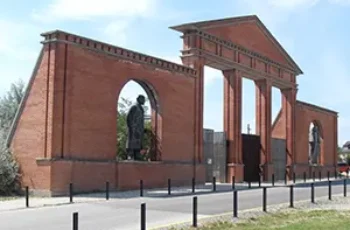One of The Best Panoramic Views of Budapest
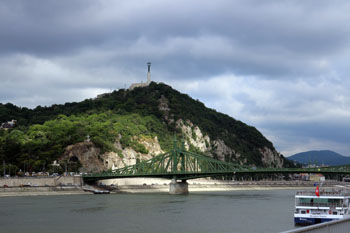
Gellért Hill is a 140-m high dolomite rock rising above the Danube in Buda.
It is one of our favourite excursion spots besides Margaret Island, the Buda Hills, or the Kopaszi Dam.
We often hike the hill with the kids, enjoying the wonderful scenery (trying to neglect the meaningless graffiti on each bench and some other nuisances) the panorama, and have a lunch or coffee with cake somewhere nearby.
If you have a couple of hours during your visit to Budapest include an excursion to Gellért Hill in your program.
Note: The Citadel, a historic fortress atop the hill is currently being refurbished so it’s closed for visitors. It will reopen with new attractions and look in 2023.
You can still explore the rest of Gellért Hill and admire the amazing view it offers so don’t hesitate to include it in your Budapest itinerary.
Quick Links:
Getting to Gellert Hill – The Citadel (Citadella–Currently Under Construction, Reopens In 2023) – Statue of Liberty (Szabadság szobor) – The Cave Church – Hotel Gellért and the Gellért Thermal Baths – The Tabán – Restaurants on Gellert Hill or nearby

Apart from the historic sights, the hill also offers some of the best spots to take photos of the city.
According to the legend, witches visited the hill every night and were riding on the back of a human being.
Besides this fantasy, the hill offers several more down-to-earth attractions:
- from the hill top you can enjoy one of the most stunning vistas of Budapest
- you’ll find many historical monuments on the hill and it
- abounds in protected natural values.
The Hill, and its environs, are part of the UNESCO’s World Heritage Sites along with the Banks of Danube in Pest from Liberty Bridge to Margaret Island.
TIP: We often go for excursions up the hill. Our kids love the slides and the playground.
Our older son was also captivated by the World War 2 and Russian artillery exhibited next to the Citadel. Note that the steep paths and the many steps are not ideal for toddlers or with pram/stroller.
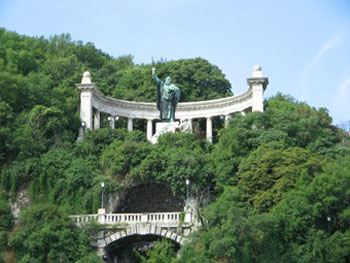
Bishop Gerard (Gellért)
Gellert Hill received its name after bishop Gerard/Gellért who came to Hungary from Italy around 1000 AD.
King St. Stephen invited him to help converting the Hungarians into Christianity.
Some resisting pagans rolled him down the hill in a barrel into the Danube in 1046.
A large statue, holding a cross in his right hand, commemorates the bishop on the northeastern slope of the hill, facing Erzsébet híd (Elizabeth Bridge).
The hill is also important from hidrogeological point of view.
Part of the drinking water supply of Budapest is stored in an inner reservoir within the hill.
The spectacular fireworks on our national holiday, 20th August are launched from the hill.
Getting to Gellert Hill
By Tram:
- No. 41,
- tram 47 and
- No 49,
By Bus:
- No. 7,
- No 86, get off: Szt. Gellért tér
Read more on Budapest’s public transportation.
The Citadel (Citadella)
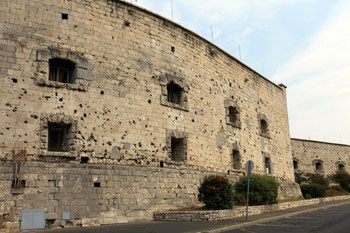
The Habsburgs realized the strategic importance of Gellert Hill: they built a fortress on top of the hill after they suppressed the 1848-49 Revolution and War of Independence.
Gun shafts aim at the Danube and the Buda Hills.
The purpose of the Citadel was to remind the rebellious Hungarians who ruled the country.
The citadel was the most despised establishment in Budapest back then and Hungarians called the it Budapest Bastille.
The Habsburgs handed it over to the City Council at the end of the 19th century.
Parts of it were symbolically destroyed.
The Citadel has served several purposes since then, it’s been a prison camp, temporary accommodation for the homeless, the site of an anti-aircraft battery and since the 1960-ies the fortress is a tourist attraction.
It’s worth coming up here, and enjoying the breathtaking vista. Walk up the upper level and whole Budapest will be sprawling in front of you. Admission is 300 HUF, cc. 1 EUR.
Statue of Liberty (Szabadság szobor) on top of Gellert Hill
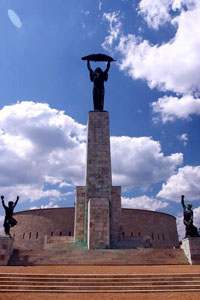
This enormous female statue stands in front of the Citadel.
You can see her from almost all parts of the city. She became the symbol of the Hungarian capital.
The Statue of Liberty commemorates Hungary’s liberation from the Nazi rule.
According to the story she was originally designed to the memory of Regent Horthy’s son.
Horthy was a right-wing leader of Hungary between the two World Wars. His son died in a plane crash.
The statue was designed to hold a propeller blade in her hands. By the time she was erected, history had Horthy swept away.
Instead of the propeller blade, a palm tree was placed in her hands and a Soviet soldier was added to the base.
Although all communist monuments were pulled down and re-erected at the edge of the town in the Memento Park, the Statue of Liberty remained.
Only the Soviet soldier from the base and the names of the Red Army soldiers who died in fights during Budapest’s siege were removed.
I can’t imagine Budapest’s city scape without the Statue of Liberty.
Cave Church on Gellért Hill

Location: just up from Szent Gellért tér, opposite the entrance to the Gellért Baths.
Open: 8.00-19.00, Admission is free.
The church was formed in a natural cave system similar to the caves in Lourdes.
It was dedicated in 1926. In the early thirties the Pauline monastery order expanded and run the church until the 1950s.
The Pauline is the only monastery order of Hungarian origin.
The order received its name after Paul, a 3rd century Egyptian hermit who lived in the desert. His only company was a raven; it brought him food, half a slice of bread every day.
In the 1950s the communist arrested the monks, executed their leader and walled the church up.
The wall was pulled down in 1989 and the church reopened. You can see a piece from this wall at the cave entrance.
See more photos on Gellert Hill taken on our excursion in September 2013..
Hotel Gellért and the Gellért Thermal Bath

There are hot thermal springs deep inside Gellért Hill that supply water for three spas.
The most famous and upscale is the Gellért Thermal Baths attached to the Hotel Gellért.
This large spa complex was built in 1918 in Art Nouveau style.
It has outdoor and indoor swimming pools, thermal pools, steam baths, sauna, offers different massage types.
Roman style marble columns support the indoor swimming pool.
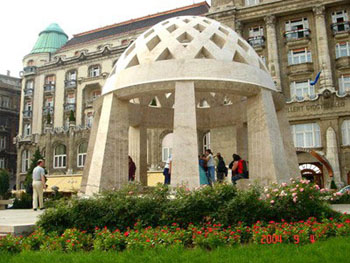
Other decorations are beautiful majolica tiles and stone lion heads spouting water.
Read more about the Gellért Bath, and the 4-star Hotel Gellért.
The Turkish-style thermal baths were once separate for women and men.
From 1st January 2013 the bath is coed, both men and women can use the pools and other services at the same time.
The drinking fountain in front of the hotel on Gellért Square has been providing water since 2004. It’s not spring water though just tap water – but it still comes handy on a sweltering day.

The Rudas Bath, a historic spa built by the Turks in medieval times, stands at the foot of Gellért Hill on Döbrentei tér.
It was refurbished a couple of years ago and has
- a thermal section with 5 hot pools + a cold pool,
- a wellness department with saunas and
- a rooftop jacuzzi with amazing view.
TIP: The Hungarian capital is a spa city, find out more about other Budapest spas.
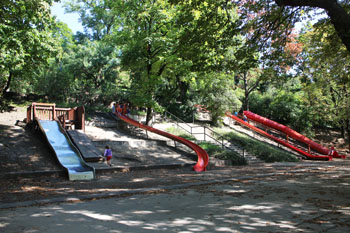

The Tabán
The northern slope of Gellert Hill is known as Tabán.
In the late 1930-ies it was densely inhabited with numerous inns and pubs. In the late 1930-ies it was densely inhabited with numerous inns and pubs.
The Tabán was a popular entertainment place. The houses had to be demolished due to public health reasons.
The Deer House still represents the old atmosphere of the palce.
This triangular building was built at the beginning of the 18th century. It was a café then; you can still see the café sign above the gate.
Today it houses the Aranyszarvas Restaurant, famous for its game dishes. In winter the snowy slopes are covered with sledging children.
In summer the Tabán becomes alive again, with many rock and folk concerts.
Must-see attractions are the two pieces from the Berlin Wall that have been erected here.
TIP: Since the two hills are close to each other, after a walk on Gellért Hill you can explore the Buda Castle District, the panorama of which you can enjoy from the top of the Hill. Devote at least half a day to each sight.
On the way to the castle you can admire the restored, historic Várkert Bazaar designed by Miklós Ybl architect.
Places to Eat on Gellert Hill or Nearby
If you love meat try one of the game dishes in Aranyszarvas Restaurant.
Address: Szarvas tér 1., I. District
Tel: +36 1 375 6451
In a sunny afternoon have freshly brewed coffee or tea with homemade desserts in the Café of the Gellért Hotel.
Address: Szt. Gellért tér 1., I. District
Tel: +36 1 889 5501
János Vendéglő
Located in Hotel Charles on Hegyalja Road offers both traditional Hungarian dishes and international cuisine specialties.
TIP: For a quick snack walk across Szabadság Bridge to Pest and have a pastry in the Great Market Hall (Vásárcsarnok). On its upper level you find buffets and restaurants as well, if you want to have a warm meal.
Address: Hegyalja út 23., I. District
Tel: +36 1 202 3414
See also our page about Best Restaurants in Budapest or our recommendation of Hungarian Restaurants in Budapest.
Pagony – An Unusual Eatery in the City

Address: Kemenes utca 10., district XI.
Open: Mon-Sun: 10.00-23.00
Pagony is located in the former children pools of the Gellért Bath.
It is a nice garden restaurant (though the original pools and showers are a bit run-down) offering Mediterranean-style dishes: quiche, burgers, steaks, desserts.
Some great Czech and Hungarian craft beers are offered on tap (550 HUF/0.5 L).
The wine list is surprisingly good as well: some nice light whites, roses, sparkling wines, champagne, prosecco: ideal for a summer evening.
Except for the champagnes all wines are available by the glass (220-580 HUF/ 1 dl).
Other Green Areas in Budapest

If you wish to get away from the hustle of the city and get some fresh, clean air head for the Buda Hills.
If you don’t have time for that visit some of the other green spots near the city center:
- Budapest Parks – Overview of Budapest Parks and Arboretums.
- Margaret Island (Margitsziget): a lovely island with lost of attractions a a summer festival in the northern part of the city.
- City Park – sights, activities in the city’s largest park.


